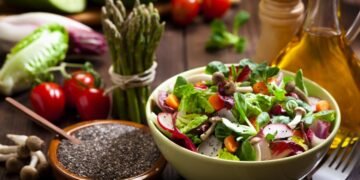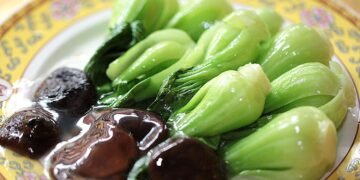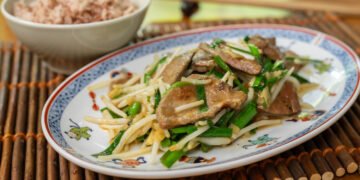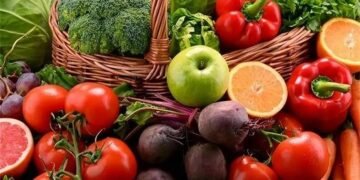In the fast-paced modern life, a quick, simple, and nutritious lunch is particularly important. Midday light salad not only provides necessary energy and nutrition, but also helps maintain weight, prevent diseases, and improve overall health. This article will explore how to achieve a comprehensive healthy lifestyle by choosing whole foods, organic ingredients, and plant-based foods, including balanced diet, nutritional supplementation, weight management, and disease prevention. We will provide a healthy diet guide, in-depth analysis of nutritious foods, the latest research in nutrition, and food safety information, and share several salad recipes that can help improve energy and vitality. Finally, we will provide a guide from the field to the dining table to help readers make more environmentally friendly and healthy food choices.
The contribution of a healthy lifestyle
1. Balanced diet: A light lunch salad can contain a variety of foods to ensure adequate intake of protein, complex carbohydrates, healthy fats, fiber, vitamins, and minerals. For example, quinoa, beans, nuts, seeds, vegetables, and fruits are all important sources of food.
2. Nutritional Supplements: Some superfoods are rich in specific nutrients such as Omega-3 fatty acids, vitamin C, and iron, which can compensate for deficiencies in daily diet. For example, chia seeds are rich in Omega-3 fatty acids, which are beneficial for heart health.
3. Weight Management: Plant based foods are usually low in calories and rich in fiber, which can help control weight and improve metabolic health. For example, oats are rich in beta glucan, which helps to lower cholesterol and blood sugar levels.
4. Disease prevention: The antioxidants and anti-inflammatory ingredients in light salad can reduce the risk of chronic diseases, such as cardiovascular disease, type 2 diabetes and some cancers. For example, anthocyanins in blueberries have strong antioxidant properties.
Healthy Eating Guide
1. Choose whole foods: Whole foods refer to unprocessed or minimally processed foods such as whole grains, beans, nuts, seeds, vegetables, and fruits. These foods retain more nutrients and fiber, which helps maintain health.
2. Organic Ingredients: Prioritize organic certified ingredients to ensure they are free of chemical pesticides and fertilizer residues, making them safer and healthier. Organic agriculture follows natural laws and helps protect the environment.
3. Plant based foods: Plant based foods are rich in fiber, vitamins, minerals, and antioxidants, which help improve energy and vitality and prevent diseases. For example, kale, beetroot, and quinoa are all high-quality plant-based ingredients.
4. Seasonal Ingredients: Choosing organic ingredients of the season not only offers more affordable prices but also higher nutritional value. Understand the seasonal ingredients of different seasons and develop corresponding recipes. For example, strawberries, spinach, and asparagus can be chosen in spring, while summer is the harvest season for tomatoes, cucumbers, and watermelons.
Healthy Salad Recipe Sharing
1. Quinoa vegetable salad
Ingredients: 1 cup of organic quinoa, 1 organic red pepper, 1 organic cucumber, 1 organic tomato, 1/4 cup of organic cherry tomato, 1 tablespoon of olive oil, 1 tablespoon of lemon juice, 1 teaspoon of honey, 1 teaspoon of mustard sauce, a little salt and black pepper
Preparation method: Boil the quinoa and cool it down for later use. Cut red peppers, cucumbers, and tomatoes into cubes, and cut cherry tomatoes in half. Put all vegetables and quinoa in a large bowl, mix olive oil, lemon juice, honey, mustard, salt and black pepper, pour on the salad, and mix well.
2. Kale, Apple, and Walnut Salad
Ingredients: 1 bundle of organic kale, 1 organic apple, 1/4 cup of organic walnut, 1/4 cup of organic dried cranberry, 1 tablespoon of olive oil, 1 tablespoon of apple cider vinegar, 1 teaspoon of honey, 1 teaspoon of mustard sauce, a little salt and black pepper
Method of making: Tear the kale into small pieces, slice the apple, and set aside dried walnuts and cranberries. Put all the ingredients into a large bowl, mix olive oil, apple vinegar, honey, mustard, salt and black pepper, pour on the salad, and mix well.
3. Beetroot Quinoa Salad
Ingredients: 1 organic beetroot, 1 cup organic quinoa, 1 organic red pepper, 1 organic cucumber, 1/4 cup organic cherry tomato, 1 tablespoon olive oil, 1 tablespoon lemon juice, 1 teaspoon honey, 1 teaspoon mustard sauce, a pinch of salt and black pepper
Preparation method: Boil the beetroot, cut it into pieces, cook the quinoa, cool and set aside. Cut red peppers, cucumbers, and tomatoes into cubes, and cut cherry tomatoes in half. Put all vegetables and quinoa in a large bowl, mix olive oil, lemon juice, honey, mustard, salt and black pepper, pour on the salad, and mix well.
4. Greek style salad
Ingredients: 1 organic cucumber, 1 organic tomato, 1 organic red pepper, 1/4 cup organic black olive, 1/4 cup organic goat cheese, 1 tablespoon olive oil, 1 tablespoon lemon juice, 1 teaspoon honey, 1 teaspoon mustard sauce, a little salt and black pepper
Preparation method: Cut cucumber, tomato, and red pepper into small pieces, then set aside black olives and goat cheese. Put all the ingredients into a large bowl, mix olive oil, lemon juice, honey, mustard, salt and black pepper, pour on the salad, and mix well.
A guide from the fields to the dining table
1. Choose organic ingredients: Prioritize organic certified ingredients to ensure they are free of chemical pesticides and fertilizer residues, making them safer and healthier. Organic agriculture follows natural laws and helps protect the environment.
2. Local procurement: Purchase locally produced organic ingredients that are not only fresh, but also reduce carbon emissions during transportation, supporting local agriculture. By participating in local farmers’ markets or joining Community Supported Agriculture (CSA) programs, one can directly interact with farmers and learn about the sources of ingredients.
3. Seasonal Ingredients: Choosing organic ingredients of the season not only offers more affordable prices but also higher nutritional value. Understand the seasonal ingredients of different seasons and develop corresponding recipes. For example, strawberries, spinach, and asparagus can be chosen in spring, while summer is the harvest season for tomatoes, cucumbers, and watermelons.
4. Sustainable Procurement: Support sustainable agriculture and fair trade, choose brands and producers that prioritize environmental protection and social responsibility. Check the packaging and labels of the product to understand its production process and environmental protection measures.
5. Reduce waste: Plan your diet reasonably and avoid excessive purchases and food waste. The remaining ingredients can be made into soup or stew, fully utilizing each part. Pay attention to freshness when storing food and extend the shelf life of ingredients.
Conclusion
By selecting and cooking a light lunch salad, we can not only enjoy a fast, simple, and nutritious lunch, but also contribute to the sustainable development of the earth. From the fields to the dining table, every step reflects care for health and the environment, allowing us to move towards a better life together. By practicing these principles of healthy eating, we can create a healthier and greener eating environment for ourselves and our families.











































